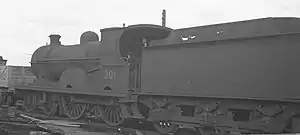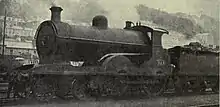GS&WR Class 301
The Great Southern and Western Railway (GS&WR) Classes 301. 305, 309 and 321 consisted of 26 4-4-0 tender locomotives designed by Robert Coey for passenger work and built between 1900 and 1907.[2]
| GS&WR 301 Class | |||||||||||||||||||||||||||||
|---|---|---|---|---|---|---|---|---|---|---|---|---|---|---|---|---|---|---|---|---|---|---|---|---|---|---|---|---|---|
 No. 301 withdrawn at Amiens St. (1962) | |||||||||||||||||||||||||||||
| |||||||||||||||||||||||||||||
| |||||||||||||||||||||||||||||
| |||||||||||||||||||||||||||||
| |||||||||||||||||||||||||||||
| |||||||||||||||||||||||||||||
Design and build
One priority at the start of the 1900s was to cater for the forecast increasing passenger train weights,[3] the Cork limited mail for example increase from a load of eight six wheeled carriages in the 1860s weight less than 100 tons to over 250 tones by 1905.[4] To address this problem Coey introduced a series of 4-4-0 locomotives that were noticeably larger than the preceding class 52 and 60.[3]
The earlier classes were somewhat restricted in steaming.[3] Records for the original 301 class seem to have some omissions and discrepancies but the Class 305, which had slightly larger heating surfaces than Class 301, were rebuilt almost immediately by 1906 with tapered saturated boilers. No. 308, rebuilt after just two years in 1904 to trial this border, was found to be seriously overweight and required remedial work on the frames to correct; this may have weakened them and it is speculated may have been the cause of the locomotives' early demise in 1933.[5]
The evolved Class 321 with its tapered boiler and larger cylinder achieving a 20% increase in tractive effort over Class 301,[3] albeit at the expense of a high axle load which restricted it to the Cork and Limerick main lines.[6]
| Feature | 301 | 305 | 309 | 321 |
|---|---|---|---|---|
| Introduced | 1900 | 1902 | 1903 | 1904 |
| Number built | 4 | 4 | 6 | 12 |
| Tractive effort | 14,500 lbf (64.50 kN) | 14,500 lbf (64.50 kN) | 15,320 lbf (68.15 kN) | 15,320 lbf (68.15 kN) |
| Cylinder size | 18 in × 26 in (457 mm × 660 mm) | 18 in × 26 in (457 mm × 660 mm) | 18 1⁄2 in × 26 in (470 mm × 660 mm) | 18 1⁄2 in × 26 in (470 mm × 660 mm) |
| Builder | Inchicore | Inchicore | Neilson | Inchicore |
| Adhesive weight | 30.55 long tons (31.04 t) | 31.45 long tons (31.95 t) | 30.9 long tons (31.4 t) | 33.5 long tons (34.0 t) |
| Max axle load | 15.95 long tons (16.21 t) | 15.75 long tons (16.00 t) | 16.0 long tons (16.3 t) | 16.75 long tons (17.02 t) |
| No. | Name | Built | Withdrawn | GSR | Inchicore | Notes |
|---|---|---|---|---|---|---|
| 301 | Victoria | 1900 | 1960 | 301 | D11 | |
| 302 | Lord Roberts | 1900 | 1957 | 301 | D11 | |
| 303 | Saint Patrick | 1900 | 1959 | 301 | D11 | |
| 304 | Princess Ena | 1900 | 1959 | 301 | D11 | |
| 305 | 1902 | 1957 | 305 | D12 | ||
| 306 | 1902 | 1959 | 305 | D12 | ||
| 307 | 1902 | 1959 | 305 | D12 | ||
| 308 | 1902 | 1933 | 305 | D12 | ||
| 309 | 1903 | 1959 | 309/310 | D13 | Rebuilt for a while as Class 321 | |
| 310 | 1903 | 1957 | 309/310 | D13 | ||
| 311 | 1903 | 1959 | 309/310 | D13 | 1930 rebuild include class 321 frames | |
| 312 | 1903 | 1959 | 309/310 | D13 | Rebuilt for a while as Class 321 | |
| 313 | 1903 | 1957 | 309/310 | D13 | ||
| 314 | 1903 | 1957 | 309/310 | D13 | ||
| 321 | 1904 | 1957 | 321 | |||
| 322 | 1905 | 1960 | 321 | |||
| 323 | 1905 | 1955 | 321 | |||
| 324 | 1905 | 1928 | 321 | |||
| 325 | 1905 | 1928 | 321 | |||
| 326 | 1905 | 1927 | 321 | |||
| 327 | 1905 | 1959 | 321 | |||
| 328 | 1905 | 1959 | 321 | |||
| 329 | 1906 | 1960 | 321 | |||
| 330 | 1906 | 1957 | 321 | |||
| 331 | 1906 | 1959 | 321 | |||
| 332 | 1906 | 1959 | 321 | |||
Service

Most of Coeys' 4-4-0 locomotives gave service through to the late 1950s of even 1960 when they were displaced by the arrival of diesels. There are suggestions that most of the few earlier withdrawals may have been due to structural issues with the need to reduce weight.
On introduction the classes were the most powerful passenger locomotives on the GS&WR and all were noted for their ability to run at speed given a light enough load. Class 321 were allocated to the Cork and Limerick expresses. The arrival of the Coey/Maunsell prototype Sir William Goulding in 1913 and Watson's Call 400 4-6-0 in 1916 that Class 321 were displaced as first choice from the Cork Mail. Only after 1923 were further 4-6-0 locomotives to appear displacing the Class 321 from some of there duties though they were still often called in to deputise.
Successors
Coey used the Class 321 as the basis for the smaller wheeled GS&WR Class 333 which had better route availability due to a lower axle loading and was better suited for mixed traffic work. Coey's last 4-4-0 design before early retirement at 60 to ill health was completed by Maunsell as the prototype Class 341 Sir William Goulding.
References
Footnotes
- Clements & McMahon (2008), pp. 102-112.
- Clements & McMahon (2008), pp. 102—112.
- Chacksfield (2010).
- Murray & McNeill (1976), p. 150.
- Clements & McMahon (2008), p. 104.
- Clements & McMahon (2008), p. 108—112.
- Clements & McMahon (2008), pp. 102-107.
Sources
- Chacksfield, J.E. (2010). Richard Maunsell - An Engineering Biography (revised ed.). Oakwood Press. pp. 33, 35, 43, 45–46. ISBN 9780853616955.
- Clements, Jeremy; McMahon, Michael (2008). Locomotives of the GSR. Newtownards: Colourpoint Books. ISBN 9781906578268. OCLC 547074718.
- Murray, K. A.; McNeill, D. B. (1976). The Great Southern & Western Railway. Irish Record Railway Society. ISBN 0904078051. OCLC 3069424.